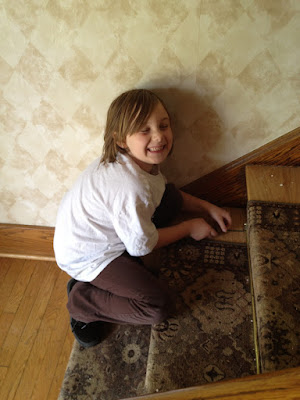And here it is folks, the SINGLE WORST thing we found in the house: outdated electricity. We had no idea it would be this bad. During the inspection, it looked as though the electrical had been upgraded fairly recently, so we didn't think we'd have to do much to it.
Were we ever wrong! After removing the plywood from the basement ceiling, we found out just how bad it was. The wiring had indeed been replaced...but only within a 10 foot radius around the panel.
 |
| The electrical panel: it looks so innocent, doesn't it? |
From there, the rest of the electrical was...knob and tube! Spliced into the new wireing simply by wirenuts and electrical tape. Many sections had additional lines patched in, which is a serious fire hazard. It all had to go. (Wondering what's so bad about knob and tube?
Read about it here.)
 |
| Knob and tube wiring |
Justin and a couple of his family members got right down to work. To make a long story short, they rewired the main panel by adding 60amp sub panel, hooked up temporarily via a 6-3 cable (to be replaced later with a conduit). This made it much easier for them to run new circuits and strip the old ones from the main panel as they went along. They also discovered a lot of unnecessary circuits, which they were then able to remove. The main panel went from being horribly overloaded to having 6 extra slots.
 |
| The panel, after removing numerous unnecessary circuits. |
 |
| Planning where to route the new circuits |
|
They also had to figure out how to run the new circuits
through the basement, then up to each floor, ending in the attic. This involved building a "raceway" for the wires, which involved taking down lath plaster.
 |
| The raceway to the second floor |
Let's not even discuss the petrified squirrel Justin found under the attic floorboards, next to a big, fluffy nest that was built around some chewed up old wire that had evidence of arcing (i.e. a fire waiting to happen).
Instead, let's discuss the fact that we now have a huge pile of old copper wire, which we can trade in for some cash!
 |
| Valuable copper wire! |
.
We also had some very important decisions to make, such as: what color do we want our outlets to be?
 |
| Why don't outlets come in blue or purple? |
Brigitte discovered that sometimes, not caring about something actually makes it harder to make a decision. Which is why she deliberated for about 10 minutes before settling on ivory (the one in the middle).
 |
| Let there be light! |
After making THAT difficult decision, Justin finished up the electrical by installing our new, ivory outlets and switches.














































